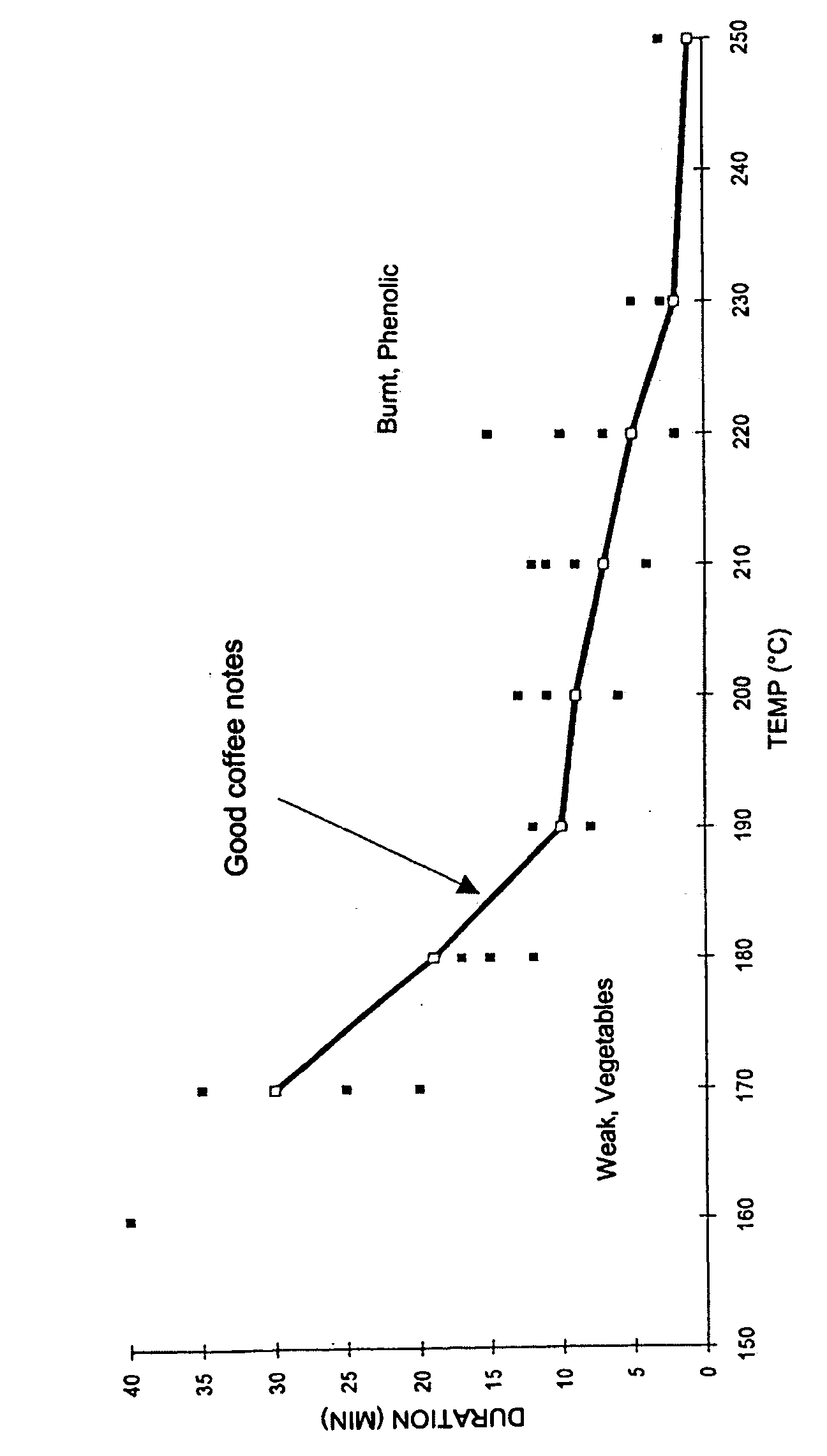Coffee extracts, their use as flavoring ingredients and as instant coffee type products
a technology of extracts and coffee, which is applied in the field of flavor and coffee industries, can solve the problems of inability to provide coffee extracts with useful organoleptic properties, affecting the taste of coffee, and further loss of volatiles, so as to improve the organoleptic properties, improve the taste of coffee, and be readily soluble in water
- Summary
- Abstract
- Description
- Claims
- Application Information
AI Technical Summary
Benefits of technology
Problems solved by technology
Method used
Image
Examples
example 1
General method for the preparation of a roasted coffee product
Extraction
[0076] In an Erlenmeyer ®, the ground coffee (from green coffee beans, grinded in an industrial grinder to provide particles having an average dimension of 0.5 to 0.7 mm) was suspended in the appropriate volume of water. The suspension, kept at the desired temperature by means of a bath, was stirred mechanically (˜600 to 900 rpm) during the selected time period. A small amount of Celite ® was then added to the suspension and the latter was filtered on a sintered glass funnel equipped with a bed of 3 cm of Celite ®. The filter was rinsed with water. The filtrate was frozen with liquid nitrogen and freeze-dried to provide an extract of green coffee according to the invention.
[0077] A PYREX ® crystalizer (diameter 70 mm) was placed in a kitchen oven the temperature of which was controlled by a SYSTAG ® type system (origin: Systegra GmbH, Germany). Once the temperature had been adjusted and stabilized...
example 2
A coffee extract was prepared following the prior art method described by De Maria et al. (reference cited), as follows:
[0080] 75 g of ground green coffee (Trottet mixture, see Example 1) were added to 400 ml of hexane and the mixture was stirred for 20 h. After filtering on a sintered glass funnel, the filtrate was dried under vacuum. There were thus obtained 70.4 g of defatted green coffee (yield 94%) and 4.6 g of slightly yellow green oil.
[0081] 50 g of this defatted coffee were suspended in 2000 ml of spring water heated to 80° C. and kept at this temperature and under stirring for 15 min. The suspension was filtered and the filtrate slightly concentrated under low vacuum, and the concentrate was frozen and freeze-dried. 13.1 g of green coffee extract were obtained (yield 26.3%). The content in chlorogenic acid of this extract was measured in a similar manner to that described in Example 1, and it was found to be 18.6 to 19% by weight. 3 g of this extract we...
example 3
Preparation of a roasted coffee product
A coffee extract was prepared from a mixture of green coffee of different origins (Trottet, Geneva, Switzerland), as follows:
[0085] A filtering phial, equipped with a sintered glass funnel of 10 cm of diameter, was charged with 50 g of mixture of ground green coffee and mineral water at room temperature (20-25° C.) was poured thereon. Slight stirring with a spatula and vacuum was applied by means of a water pump (˜4 min). Freeze-drying thus provided a first solid green coffee extract (3.9 g ; yield 7.7%).
[0086] 200 ml of demineralised water, at the same temperature, were then poured on the already extracted 50 g of coffee, letting it gently run for about 5 min and rapidly concentrating under vacuum (˜12 min). A second solid extract was thus obtained (5.8 g ; yield 11.6%). A third extraction of this coffee with 200 ml of water, applying quick vacuum (˜15 min) and freeze-drying the solution, provided a third solid extract (1.6 g ; yield 3.2%...
PUM
 Login to View More
Login to View More Abstract
Description
Claims
Application Information
 Login to View More
Login to View More - R&D
- Intellectual Property
- Life Sciences
- Materials
- Tech Scout
- Unparalleled Data Quality
- Higher Quality Content
- 60% Fewer Hallucinations
Browse by: Latest US Patents, China's latest patents, Technical Efficacy Thesaurus, Application Domain, Technology Topic, Popular Technical Reports.
© 2025 PatSnap. All rights reserved.Legal|Privacy policy|Modern Slavery Act Transparency Statement|Sitemap|About US| Contact US: help@patsnap.com

